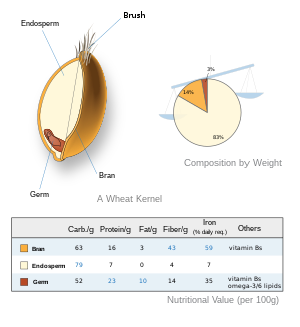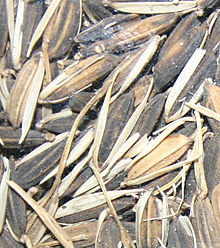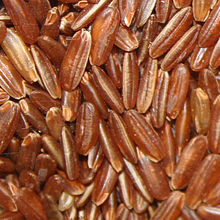
A whole grain is a grain of any cereal and pseudocereal that contains the endosperm, germ, and bran, in contrast to refined grains, which retain only the endosperm.[1][2][3]
As part of a general healthy diet, consumption of whole grains is associated with lower risk of several diseases.[4][5] Whole grains are a source of carbohydrates, multiple nutrients and dietary fiber.
Varieties
[edit]Whole grain sources include:[1][6]
Cereals
- Wheat (spelt, emmer, farro, einkorn, Kamut, durum)
- Rice (Black rice, brown, red, and other colored rice varieties)
- Barley (hulled and dehulled but not pearl)
- Maize or corn
- Rye
- Oats (including hull-less or naked oats)



Minor cereals
- Millets
- Sorghum
- Teff
- Triticale
- Canary grass
- Job's tears
- Fonio, black fonio, Asian millet
- Wild rice
Pseudocereals
Health effects
[edit]Nutrition
[edit]Whole grains are a source of multiple nutrients and dietary fiber, recommended for children and adults in several daily servings containing a variety of foods that meet whole grain-rich criteria.[7][8][9] As components of breakfast cereals, whole grains are associated with improved micronutrient intake and lower risk of several diseases.[10] Their effects on gastrointestinal health, risk of obesity and cognition need further evaluation.[11]
Cereal proteins have low quality, due to deficiencies in essential amino acids, mainly lysine.[12][13] Supplementation of cereals with proteins from other food sources (mainly legumes) is commonly used to compensate for this deficiency,[13] since the limitation of a single essential amino acid causes the others to break down and become excreted, which is especially important during the period of growth.[14] In contrast, the proteins of the pseudocereals have a high nutritional value, close to those of casein (the main protein in milk).[6] Quinoa and amaranth are the most nutritious grains due to their high content and quality of proteins, with high levels of lysine and other essential amino acids.[6][15]
Disease risk
[edit]Manufacturers of foods containing whole grains in specified amounts are allowed a health claim for marketing purposes in the United States, stating: "low fat diets rich in fiber-containing grain products, fruits, and vegetables may reduce the risk of some types of cancer, a disease associated with many factors" and "diets low in saturated fat and cholesterol and rich in fruits, vegetables, and grain products that contain some types of dietary fiber, particularly soluble fiber, may reduce the risk of heart disease, a disease associated with many factors".[16][17][18] The scientific opinion of the European Food Safety Authority (EFSA) related to health claims on gut health or bowel function, weight control, blood glucose and insulin levels, weight management, blood cholesterol, satiety, glycemic index, digestive function and cardiovascular health is "that the food constituent, whole grain, (...) is not sufficiently characterised in relation to the claimed health effects" and "that a cause and effect relationship cannot be established between the consumption of whole grain and the claimed effects considered in this opinion."[19]
By supplying high dietary fiber content, as part of a general healthy diet, consumption of whole grains may lower risk of several diseases, including coronary heart disease, stroke and cancer, with lower all-cause mortality.[4][20][10] Regular whole-grain consumption may lower elevated LDL and triglyceride levels, which are risk factors for cardiovascular diseases.[20] Whole grain consumption is associated with a lower risk of type 2 diabetes.[10][21][22]
In 2012, Health Canada stated that "the evidence to date from clinical trials and prospective cohort studies was not sufficient to support a whole grains and coronary heart disease risk reduction claim in Canada".[23] A 2017 review of clinical trials found insufficient evidence for a relationship between whole grain consumption and lowered risk of cardiovascular diseases.[24]
The American Institute for Cancer Research and World Cancer Research Fund International have stated that there is strong evidence that whole grains decrease risk of colorectal cancer.[5][25][26]
Gluten concerns
[edit]In genetically susceptible people, gluten (proteins found in wheat, barley, rye, oat, and related species and hybrids)[27] can trigger coeliac disease.[28] Coeliac disease affects about 1% of the general population in developed countries.[28][29] There is evidence that most cases remain undiagnosed and untreated.[28] The only known effective treatment is a strict lifelong gluten-free diet.[28] Minor cereals and pseudocereals may be a reasonable alternative to replace gluten-containing cereals for people who need to follow a gluten-free diet.[6]
While coeliac disease is caused by a reaction to wheat proteins, it is not the same as a wheat allergy.[28][29] Other diseases triggered by eating gluten are non-coeliac gluten sensitivity,[29][30] (estimated to affect 0.5% to 13% of the general population),[31] gluten ataxia and dermatitis herpetiformis.[30]
Regulations
[edit]In the United States wholegrain products can be identified by the ingredients list. "Wheat flour" (as opposed to "wholegrain wheat flour" or "whole-wheat flour") as the first ingredient is not a clear indicator of the product's wholegrain content. If two ingredients are listed as grain products but only the second is listed as wholegrain, the entire product may contain between 1% and 49% wholegrain.[32] Many breads are colored brown (often with molasses or caramel color) and made to look like wholegrain when they are not. In addition, some food manufacturers make foods with wholegrain ingredients, but, because wholegrain ingredients are not the dominant ingredient, they are not wholegrain products. Contrary to popular belief, wholegrains are not indicative of fiber. The amount of fiber varies from grain to grain, and some products may have things like bran, peas, or other foods added to boost the fiber content.[33]
From AACC (American Association of Cereal Chemists) definition: "Whole grains shall consist of the intact, ground, cracked or flaked caryopsis, whose principal anatomical components - the starchy endosperm, germ and bran - are present in the same relative proportions as they exist in the intact caryopsis."
U.S. standards of identity
[edit]The following names indicate whole-grain products, in accordance with the federal government:[34][35][36]
- "Whole wheat bread"
- "Whole millet"
- "Whole wheat buns"
- "Whole wheat macaroni"
- "Whole wheat spaghetti"
- "Whole wheat vermicelli"
- "Cracked wheat" (as an ingredient, not as part of a product name like "cracked wheat bread")
- "Crushed wheat"
- "Whole wheat flour"
- "Graham flour" (as an ingredient, not as part of a product name like "graham crackers")
- "Entire wheat flour"
- "Bromated whole wheat flour"
- "Whole durum flour"
- "Bulgur (cracked wheat)" ("bulgur" by itself may or may not indicate whole grain, and "cracked wheat" is not synonymous with bulgur)
Canadian standards of identity
[edit]There are multiple grains such as cereal grains (e.g. wheat, rice, oats, barley, corn, wild rice, and rye) as well as pseudocereals (e.g. quinoa and buckwheat) that may be labeled whole grains.[37]
When wheat is milled to make flour, the parts of the grain are usually separated and then are recombined to make specific types of flour, such as whole wheat, whole grain, white cake and pastry flour, and all-purpose white flour. If all parts of the kernel are used in the same relative proportions as they exist in the original kernel, then the flour is considered whole grain.
Under the Food and Drug Regulations, up to 5% of the kernel can be removed to help reduce rancidity and prolong the shelf life of whole-wheat flour. The portion of the kernel that is removed for this purpose contains much of the germ and some of the bran. If this portion of the kernel has been removed, the flour would no longer be considered whole grain.
UK regulations
[edit]In the UK the legally protected term is wholemeal rather than wholegrain.[38] There are voluntary guidelines on what can be labelled a wholegrain product.[38]
See also
[edit]- Ancient grains
- Alkylresorcinols
- Refined grains
- Unifine mill
- Wheatberry
- Whole foods
- Whole grain stamp
References
[edit]- ^ a b van der Kamp, Jan Willem; Poutanen, Kaisa; Seal, Chris J.; Richardson, David P. (2014-02-04). "The HEALTHGRAIN definition of 'whole grain'". Food & Nutrition Research. 58 (1): 22100. doi:10.3402/fnr.v58.22100. ISSN 1654-6628. PMC 3915794. PMID 24505218.
- ^ "Definition of Whole Grain as Food Ingredient" (PDF). Whole Grain Initiative. 2022-01-21.
- ^ van der Kamp, JW (2013). "Whole Grain Definition: New Perspectives for Inclusion of Grains and Processing but not for Analysis" (PDF). CFW Plexus. doi:10.1094/CPLEX-2013-1001-08B. Retrieved 3 June 2017.
- ^ a b "Whole Grains, Refined Grains, and Dietary Fiber". American Heart Association. 2021. Retrieved 25 October 2023.
- ^ a b "Wholegrains, vegetables and fruit and the risk of cancer". wcrf.org. Retrieved 25 October 2023.
- ^ a b c d Saturni L, Ferretti G, Bacchetti T (2010). "The gluten-free diet: safety and nutritional quality". Nutrients (Review). 2 (1): 16–34. doi:10.3390/nu2010016. PMC 3257612. PMID 22253989.
- ^ "Whole Grain Fact Sheet". European Food Information Council. 1 January 2009. Archived from the original on 2009-05-11. Retrieved 6 December 2016.
- ^ "Whole Grain Resource for the National School Lunch and School Breakfast Programs: A Guide to Meeting the Whole Grain-Rich Criteria" (PDF). US Department of Agriculture, Food and Nutrition Service. January 2014.
Additionally, menu planners are encouraged to serve a variety of foods that meet whole grain-rich criteria and may not serve the same product every day to count for the HUSSC whole grain-rich criteria.
- ^ "All About the Grains Group". US Department of Agriculture, MyPlate. 2016. Retrieved 6 December 2016.
- ^ a b c Williams, P. G. (2014). "The benefits of breakfast cereal consumption: A systematic review of the evidence base". Advances in Nutrition. 5 (5): 636S–673S. doi:10.3945/an.114.006247. PMC 4188247. PMID 25225349.
- ^ Priebe, M. G.; McMonagle, J. R. (2016). "Effects of Ready-to-Eat-Cereals on Key Nutritional and Health Outcomes: A Systematic Review". PLOS ONE. 11 (10): e0164931. Bibcode:2016PLoSO..1164931P. doi:10.1371/journal.pone.0164931. PMC 5066953. PMID 27749919.
- ^ Shewry, PR. "Impacts of agriculture on human health and nutrition – Vol. II - Improving the Protein Content and Quality of Temperate Cereals: Wheat, Barley and Rye" (PDF). UNESCO - Encyclopedia Life Support Systems (UNESCO-EOLSS). Retrieved 2 June 2017.
When compared with the WHO requirements of essential amino acids for humans, wheat, barley and rye are seen to be deficient in lysine, with threonine being the second limiting amino acid (Table 1).
- ^ a b "Nutritional quality of cereals". Food and Agriculture Organization of the United Nations. Retrieved 1 June 2017.
- ^ Shewry PR, Hey SJ (2015). "Review: The contribution of wheat to human diet and health". Food and Energy Security. 4 (3): 178–202. doi:10.1002/fes3.64. PMC 4998136. PMID 27610232.
- ^ Robin F, Théoduloz C, Srichuwong S (2015). "Properties of extruded whole grain cereals and pseudocereals flours". International Journal of Food Science & Technology. 50 (10): 2152–2159. doi:10.1111/ijfs.12893. Retrieved 3 June 2017.
- ^ "Health Claim Notification for Whole Grain Foods". Bethesda, MD: Food and Drug Administration, US Department of Health and Human Services. July 1999. Retrieved 4 December 2016.
- ^ "Guidance for Industry: A Food Labeling Guide (11. Appendix C: Health Claims)". Bethesda, MD: Food and Drug Administration, US Department of Health and Human Services. January 2013.
- ^ "Food Labeling: Health Claims; Soluble Dietary Fiber From Certain Foods and Coronary Heart Disease". Federal Register. Retrieved 7 October 2020.
- ^ European Food Safety Authority (EFSA), EFSA Panel on Dietetic Products, Nutrition and Allergies (NDA) (2010). "Scientific Opinion on the substantiation of health claims related to whole grain (ID 831, 832, 833, 1126, 1268, 1269, 1270, 1271, 1431) pursuant to Article 13(1) of Regulation (EC) No 1924/2006". EFSA Journal. 8 (10): 1766. doi:10.2903/j.efsa.2010.1766.
((cite journal)): CS1 maint: multiple names: authors list (link) - ^ a b Aune, D; Keum, N; Giovannucci, E; Fadnes, L. T.; Boffetta, P; Greenwood, D. C.; Tonstad, S; Vatten, L. J.; Riboli, E; Norat, T (2016). "Whole grain consumption and risk of cardiovascular disease, cancer, and all cause and cause specific mortality: Systematic review and dose-response meta-analysis of prospective studies". BMJ. 353: i2716. doi:10.1136/bmj.i2716. PMC 4908315. PMID 27301975.
- ^ Ye EQ, Chacko SA, Chou EL, Kugizaki M, Liu S. (2012). "Greater Whole-Grain Intake Is Associated with Lower Risk of Type 2 Diabetes, Cardiovascular Disease, and Weight Gain". The Journal of Nutrition. 142 (7): 1304–1313. doi:10.3945/jn.111.155325. PMC 6498460. PMID 22649266.
((cite journal)): CS1 maint: multiple names: authors list (link) - ^ Hu Y, Ding M, Sampson L, Willett WC, Manson JE, Wang M, Rosner B, Hu FB, Sun Q. (2020). "Intake of whole grain foods and risk of type 2 diabetes: results from three prospective cohort studies". BMJ. 370: m2206. doi:10.1136/bmj.m2206. PMC 7341349. PMID 32641435.
((cite journal)): CS1 maint: multiple names: authors list (link) - ^ "Summary of Health Canada's Assessment of a Health Claim about Whole Grains and Coronary Heart Disease". canada.ca. Retrieved 25 October 2023.
- ^ Kelly, Sarah AM; Hartley, Louise; Loveman, Emma; Colquitt, Jill L; Jones, Helen M; Al-Khudairy, Lena; Clar, Christine; Germanò, Roberta; Lunn, Hannah R; Frost, Gary; Rees, Karen (2017-08-24). "Whole grain cereals for the primary or secondary prevention of cardiovascular disease". Cochrane Database of Systematic Reviews. 8 (5): CD005051. doi:10.1002/14651858.cd005051.pub3. ISSN 1465-1858. PMC 6484378. PMID 28836672.
- ^ "Wholegrains, vegetables, fruit and cancer risk". wcrf.org. Retrieved 25 October 2023.
- ^ "Whole Grains: Protect Against Colorectal Cancer". aicr.org. Retrieved 25 October 2023.
- ^ Biesiekierski JR (2017). "What is gluten?". J Gastroenterol Hepatol (Review). 32 (Suppl 1): 78–81. doi:10.1111/jgh.13703. PMID 28244676.
Similar proteins to the gliadin found in wheat exist as secalin in rye, hordein in barley, and avenins in oats and are collectively referred to as "gluten." The gluten found in all of these grains has been identified as the component capable of triggering the immune-mediated disorder, coeliac disease.

- ^ a b c d e "Celiac disease". World Gastroenterology Organisation Global Guidelines. July 2016. Retrieved 7 December 2016.
- ^ a b c "Definition and Facts for Celiac Disease". The National Institute of Diabetes and Digestive and Kidney Diseases, National Institutes of Health, US Department of Health and Human Services, Bethesda, MD. 2016. Retrieved 5 December 2016.
- ^ a b Ludvigsson JF, Leffler DA, Bai JC, Biagi F, Fasano A, Green PH, Hadjivassiliou M, Kaukinen K, Kelly CP, Leonard JN, Lundin KE, Murray JA, Sanders DS, Walker MM, Zingone F, Ciacci C (January 2013). "The Oslo definitions for coeliac disease and related terms". Gut. 62 (1): 43–52. doi:10.1136/gutjnl-2011-301346. PMC 3440559. PMID 22345659.
- ^ Molina-Infante J, Santolaria S, Sanders DS, Fernández-Bañares F (May 2015). "Systematic review: noncoeliac gluten sensitivity". Aliment Pharmacol Ther. 41 (9): 807–20. doi:10.1111/apt.13155. PMID 25753138. S2CID 207050854.
- ^ "Whole Grains Council - Intro to Whole Grains". Retrieved 2007-10-10.
- ^ "Whole Grains Council - Identifying Whole Grain Products". Retrieved 2008-02-10.
- ^ "21 CFR 136". Archived from the original on 2007-12-21. Retrieved 2008-02-10.
- ^ "21 CFR 137". Archived from the original on 2007-11-02. Retrieved 2008-02-10.
- ^ "21 CFR 139". Archived from the original on 2007-11-02. Retrieved 2008-02-10.
- ^ "Whole Grains - Get the Facts". hc-sc.gc.ca. 2007-06-29. Retrieved 17 May 2015.
- ^ a b Real Bread Grain: Wholegrain – UK. sustainweb.org.
External links
[edit]- Article from BBC news
- Definition of Whole Grain
- U.S. FDA Guidance on Whole Grain Label Statements (Draft)
| History | ||
|---|---|---|
| Types of barley |
| |
| Agronomy | ||
| Trade | ||
| Parts of the plant | ||
| Basic preparations | ||
| As an ingredient | ||
| Associated human diseases | ||
| Related concepts | ||
| Types | ||
|---|---|---|
| Agronomy | ||
| Trade | ||
| Plant parts and their uses | ||
| Basic preparation | ||
| As an ingredient | ||
| Associated human diseases | ||
| Related concepts | ||
| Perspectives |
| ||||||
|---|---|---|---|---|---|---|---|
| Ethics |
| ||||||
| Food and drink |
| ||||||
| Groups and events |
| ||||||
| Companies | |||||||
| Books, reports, journals |
| ||||||
| Films and shows |
| ||||||
| Magazines | |||||||
| Academics, activists, authors, physicians |
| ||||||
| Chefs and cookbook authors |
| ||||||
| Restaurants | |||||||
| Former restaurants | |||||||
| Related | |||||||

